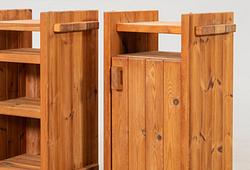A Dutch Delft polychrome faience ewer, early 18th Century.
After a european silver model, decorated in 'imair-verte colours. Height 16 cm.
The decoration of this jug is a typical Dutch interpretation of the Japanese Imari. The asymmetry is formed by a blue section on the right and the open scenery with the depiction of a flowering plant and birds in flight. Furthermore the colour pattern of the Japanese Imari porcelain wares is extended with a light green colour. Often we see jugs with a silver or pewter hinge, but this jug has a separate faience cover. Since a jug without a hinge is not really much of a use, this can indicate that the jug was never used and possibly put away in a cupboard.
Wear.
Tuontiarvonlisävero
Tuontiarvonlisävero (12%) tullaan veloittamaan tämän esineen vasarahinnasta. Lisätietoja saat soittamalla Ruotsin asiakaspalvelumme numeroon +46 8-614 08 00.
Alkuperä - Provenienssi
From the Collection of Tove and Karl Emil Strømstad (born 1936), Norway. The couple built their collection over the decades. They started to collect in the early 1970's after buying the first piece, a famille rose bowl, dating from the 18th Century. Mr Strømstads work at IBM brought the couple and their family to various places around the world and they built their vast academic collection of ceramics dating from the Han dynasty to the Qing dynasty by visiting auction houses, antique dealers and antique fairs. Always striving to acquire pieces form different epoques and constantly seeking more knowledge about the pieces, the techniques and their history.
Strømstad label 342. Purchased from Perles, June 2010.
Näyttelyt
Compare an ewer and basin in the Getty Collection, inv no 98137lck190715_24406. Also with a lambrequin edge, of the same period and marked with the Grieksche A, Delft, c. 1701 - c. 1722.
Kirjallisuus
For other items from this collection, se Sothebys, Asian Arts / 5000 Years. 18 April 2023. Paris. Lot no 1-39.
See also object from this collection in the Asian catalogue in this Bukowskis sale lot no 1142-1225.

















































